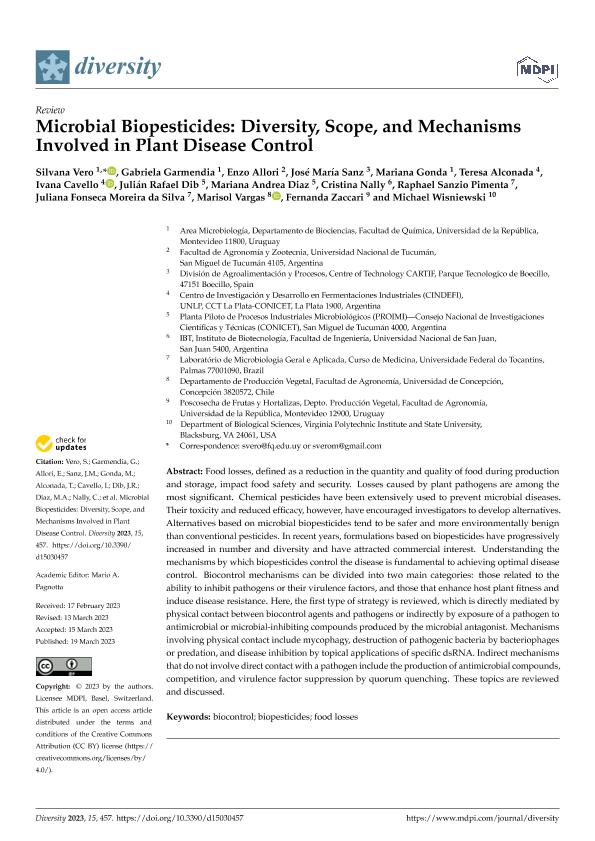Artículo
Microbial Biopesticides: Diversity, Scope, and Mechanisms Involved in Plant Disease Control
Vero, Silvana; Garmendia, Gabriela; Allori Stazzonelli, Enzo ; Sanz, José María; Gonda, Mariana; Alconada Magliano, Teresa Maria
; Sanz, José María; Gonda, Mariana; Alconada Magliano, Teresa Maria ; Cavello, Ivana Alejandra
; Cavello, Ivana Alejandra ; Dib, Julian Rafael
; Dib, Julian Rafael ; Diaz, Mariana Andrea
; Diaz, Mariana Andrea ; Nally, Maria Cristina
; Nally, Maria Cristina ; Pimenta, Raphael Sanzio; Fonseca Moreira da Silva, Juliana; Vargas, Marisol; Zaccari, Fernanda; Wisniewski, Michael
; Pimenta, Raphael Sanzio; Fonseca Moreira da Silva, Juliana; Vargas, Marisol; Zaccari, Fernanda; Wisniewski, Michael
 ; Sanz, José María; Gonda, Mariana; Alconada Magliano, Teresa Maria
; Sanz, José María; Gonda, Mariana; Alconada Magliano, Teresa Maria ; Cavello, Ivana Alejandra
; Cavello, Ivana Alejandra ; Dib, Julian Rafael
; Dib, Julian Rafael ; Diaz, Mariana Andrea
; Diaz, Mariana Andrea ; Nally, Maria Cristina
; Nally, Maria Cristina ; Pimenta, Raphael Sanzio; Fonseca Moreira da Silva, Juliana; Vargas, Marisol; Zaccari, Fernanda; Wisniewski, Michael
; Pimenta, Raphael Sanzio; Fonseca Moreira da Silva, Juliana; Vargas, Marisol; Zaccari, Fernanda; Wisniewski, Michael
Fecha de publicación:
03/2023
Editorial:
Multidisciplinary Digital Publishing Institute
Revista:
Diversity
ISSN:
1424-2818
Idioma:
Inglés
Tipo de recurso:
Artículo publicado
Clasificación temática:
Resumen
Food losses, defined as a reduction in the quantity and quality of food during production and storage, impact food safety and security. Losses caused by plant pathogens are among the most significant. Chemical pesticides have been extensively used to prevent microbial diseases. Their toxicity and reduced efficacy, however, have encouraged investigators to develop alternatives. Alternatives based on microbial biopesticides tend to be safer and more environmentally benign than conventional pesticides. In recent years, formulations based on biopesticides have progressively increased in number and diversity and have attracted commercial interest. Understanding the mechanisms by which biopesticides control the disease is fundamental to achieving optimal disease control. Biocontrol mechanisms can be divided into two main categories: those related to the ability to inhibit pathogens or their virulence factors, and those that enhance host plant fitness and induce disease resistance. Here, the first type of strategy is reviewed, which is directly mediated by physical contact between biocontrol agents and pathogens or indirectly by exposure of a pathogen to antimicrobial or microbial-inhibiting compounds produced by the microbial antagonist. Mechanisms involving physical contact include mycophagy, destruction of pathogenic bacteria by bacteriophages or predation, and disease inhibition by topical applications of specific dsRNA. Indirect mechanisms that do not involve direct contact with a pathogen include the production of antimicrobial compounds, competition, and virulence factor suppression by quorum quenching. These topics are reviewed and discussed.
Palabras clave:
BIOCONTROL
,
BIOPESTICIDES
,
FOOD LOSSES
Archivos asociados
Licencia
Identificadores
Colecciones
Articulos(CCT - SAN JUAN)
Articulos de CENTRO CIENTIFICO TECNOLOGICO CONICET - SAN JUAN
Articulos de CENTRO CIENTIFICO TECNOLOGICO CONICET - SAN JUAN
Articulos(CINDEFI)
Articulos de CENT.DE INV EN FERMENTACIONES INDUSTRIALES (I)
Articulos de CENT.DE INV EN FERMENTACIONES INDUSTRIALES (I)
Articulos(PROIMI)
Articulos de PLANTA PILOTO DE PROC.IND.MICROBIOLOGICOS (I)
Articulos de PLANTA PILOTO DE PROC.IND.MICROBIOLOGICOS (I)
Citación
Vero, Silvana; Garmendia, Gabriela; Allori Stazzonelli, Enzo; Sanz, José María; Gonda, Mariana; et al.; Microbial Biopesticides: Diversity, Scope, and Mechanisms Involved in Plant Disease Control; Multidisciplinary Digital Publishing Institute; Diversity; 15; 3; 3-2023; 1-29
Compartir
Altmétricas



